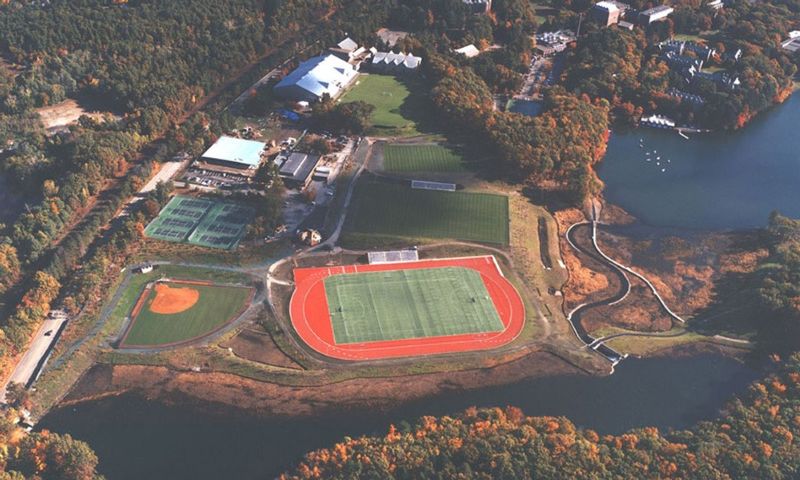Haley & Aldrich
Costa Mesa, CA 92626
Featured Project Return to Projects List
Wellesley College
Project Information
- Project Location:
- Wellesley, CA
- Status:
- Completed
- Structure Type:
- School / College / University
Scope Of Work
In 1932, Wellesley College purchased land adjacent to the campus to expand their campus footprint. The land was formerly occupied by a factory that manufactured heavy metals-based paint pigments. When the college discovered lead- and chromium-contaminated soils and sediments on their property, officials understood they needed to quickly isolate and cover areas posing significant threats. Pigment-impacted soils and sediments were then excavated and removed. But the college also needed to address the short- and long-term risks to human health and the environment. They wanted to remove those threats and restore the land near the campus and Lake Waban.
Wellesley needed a partner to help design and build a solution that transformed the environmental liability into a valuable campus asset. Knowing Haley & Aldrich’s reputation for overcoming geotechnical and environmental challenges in New England, Wellesley asked us to work with the college to assess the property and surrounding land, evaluate remedial alternatives, and help negotiate the recommended alternative with stakeholders.
Our approach
Preliminary analysis by Massachusetts regulators suggested the need for groundwater, sediment, and upland soil remedies that when combined would have cost Wellesley over $200 million. These remedies included upland soil removal, dredging significant portions of the adjacent lake and brook, and transporting sediments and excavated soils to out-of-state hazardous waste landfills.
When Haley & Aldrich started our remedial investigations, our overall project goal was to find the college more cost-effective solutions that still addressed everyone’s primary concern—protecting human health and the environment.
Using high-resolution site characterization, we identified previously unknown source areas of chromium contaminating the groundwater. This allowed us to focus our groundwater remedy on those source areas with natural attenuation following source remediation, saving Wellesley millions of dollars.
Our engineers and scientists also used scanning electron microscopy with an energy dispersive x-ray analysis to differentiate chromium compounds and understand the varying leachability characteristics of the pigments and related manufacturing ingredients and residues (and their associated color) found in soils. Combined with hydrogeologic models, this data informed our remedial alternatives and our conceptual site model. Ultimately, we utilized the data and models to demonstrate that much of the pigment-impacted soil did not require pre-treatment before on-site consolidation to reduce leaching of hexavalent chromium, saving millions in added cost.
The project team cleared thirty acres of the site and excavated and handled more than 500,000 cubic yards of soils and sediments to reshape the land for redevelopment. We gained consensus from regulators that roughly 200,000 of those cubic yards exhibiting pigment contamination could be consolidated on site and covered with a protective engineered barrier. Of this volume of pigment waste consolidated on site, we used chemical reduction and stabilization to treat 30,000 cubic yards of soil contaminated with hexavalent chromium with high leaching potential before placing it in the consolidation area.
Not only did on-site consolidation save Wellesley $80 million in off-site disposal costs, but our more sustainable approach also spared the area from significant truck traffic, noise, and emissions. And we were able to use the treated soil as fill for shaping the land to support new athletic fields.
By demonstrating that risks from Lake Waban’s contaminated sediments were limited to a small, shallow portion along the shoreline, we avoided dredging an additional 200,000 cubic yards of sediments—enough to fill over 12,000 dump trucks.
Similarly, we characterized sediments in the Lower Waban Brook and demonstrated to regulators that the impacted areas were less than a third of the original estimates. Moreover, after we interpreted our results and negotiated the scope with the regulatory agency, we completed a detailed risk assessment and sediment bioavailability study for Lower Waban Brook. Our results showed those sediments did not pose a risk to human health or the environment, eliminating the need for Lower Waban Brook sediment remediation.
Through these methods, we significantly reduced the amount of sediment that needed dredging in both Lake Waban and Lower Waban Brook. And we incorporated the 7,500 cubic yards of dredged material from the Lake Waban shoreline into the upland consolidation area, reducing initially estimated off-site disposal costs by a third.
Value delivered
Remediated and reused valuable land as a running track, field hockey, soccer, and softball fields, and a 7-acre wetlands ecology study area
Garnered regulatory approval for a natural attenuation remedy and reduced groundwater monitoring frequency from 75 wells quarterly to 38 wells annually, saving the college as much as $20 million
Used our knowledge of the site, the permitting requirements, and our client’s goals and expectations to help Wellesley prepare bid documents and select a construction contractor that fit their budget, schedule, and needs
